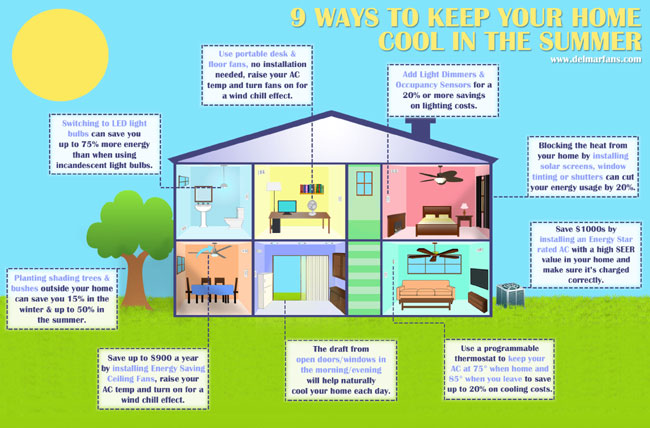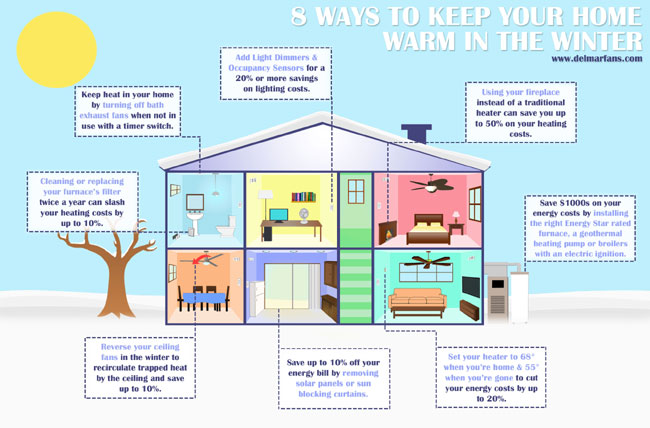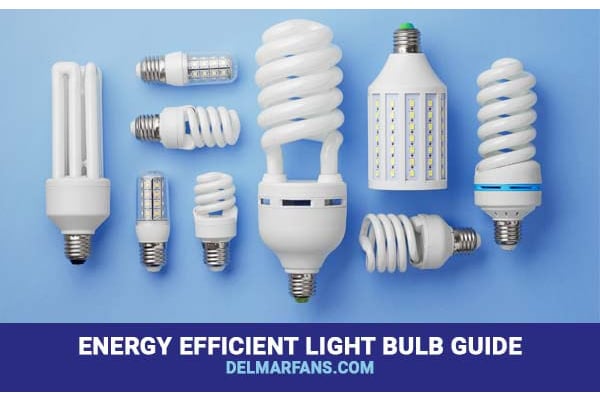The U.S. Environmental Protection Agency (EPA) averages most families spend roughly $1,900 a year on electricity. The bulk of that comes directly from the heating and cooling of your home. Adjusting a handful of factors, such as choosing the right light bulbs, will save your wallet and the environment big time. We will break these energy efficient heating and cooling tips into winter, summer and anytime categories. At the end of this article we will highlight why energy efficient heating and cooling is so important to our environment.
Keeping it Efficiently Cool in Summer
If you’re trying to beat the summer heat without beating up your electric bill or the environment, we have a great list of summer energy efficient cooling tips for you. We have compiled them in order ranging from easy-peasy to serious-lifting.
*Click the image to open a larger version.
- Lower your AC. A good rule of thumb when using your AC in the summer is to try to keep it at 78 degrees when you are home and 85 degrees when you leave your home. Do not turn the unit completely off unless you’re leaving for more than 24 hours. You will be saving one to three percent of your energy bill for every degree higher you set it. Consider using this tactic with energy saving ceiling fans to help keep you cool.
- Let a draft flow. One main reason your home begins to heat up is the lack of air circulation. Opening the windows and doors in the early mornings or evenings, when the temperature is still low outside, will allow cool air to move through, letting your home cool itself naturally before the summer heat kicks in. Pair this technique with high-end ceiling fans, desk fans or floor fans and you will not even need your AC on during the first part of the day.
- Consider new light bulbs. Our Facts About Energy Efficient Light Bulbs article outlines the different types of energy saving light bulbs, but we want to highlight that when you switch your light bulbs from the old incandescent or halogen flood bulbs to energy saving LED light bulbs(AKA light-emitting diodes) you’re adding to your savings. Switching to LEDs can save you up to 75 percent per bulb. You are saving on your lighting energy usage and your heating and cooling. LEDs do not emit heat like other bulbs. This will help keep your home a few degrees cooler overall. Another way to beat the heat is to replace some of the light fixtures in a room with a ceiling fan with lights. Controllable ceiling fans with lights will cool you down while providing ample lighting for a room.
- Block the sun. If a room in your home gets direct exposure to sunlight you’re going to want to keep that heat from entering your home. A wide selection of energy efficient sun blocking curtains are now available at many stores and online. Solar screens, window tinting or shutters are the most efficient way to block the suns heat. They go on the outside of your windows and act as a heat shield for your home. These techniques can help you save up to 20 percent off your energy bill.
- Use your green thumb. Find the areas of your home that get the most sun exposure in the summer time and plant your favorite types of trees there. This is not an instant fix, but in a few years shady trees could help save you big time on your home cooling costs. Utilizing these techniques in your home have energy packed savings of 15 percent in the winter and up to 50 percent in the summer.
- Use energy saving ceiling fans. Energy Star ceiling fans use the latest technology to save energy, and manufacturers like Quorum offer a wide variety of Energy Star ceiling fans. Ceiling fans are not meant to cool rooms, they are meant to cool people. So, only use the fans when a person is in that room. Having ceiling fans in different parts of your home can significantly save you on your energy bill. It costs between two to seven cents an hour to run a ceiling fan, meanwhile, your air conditioner costs in-between 17 to 30 cents an hour depending on the type/temperature. Even the most expensive ceiling fan versus the cheapest AC unit saves you almost $900 a year.
- Consider portable fans. If installing a ceiling fan in your home is not an option for you, consider buying portable desk fans or floor fans. No installation necessary and these fans can move from room to room while still saving you up to 65 percent on your heating and cooling costs. As a bonus, many of these fans are extremely stylish.
- Choosing the right AC. This is a big one and we know many homes do not get a choice in the matter, but if you do get to choose your AC unit we recommend picking a Energy Star qualified product with a higher Seasonal Energy Efficiency Ratio (SEER). The higher the SEER the better the AC will be at saving energy. Sizing and proper installation are key when installing a new AC so pick a high quality technician to help you. Make sure enough room is left for serving your new AC and making sure it’s charged correctly. Over 60 percent of newly installed AC units are charged incorrectly.
Staying Energy Saving Toasty in Winter
Don't let the winter cold keep you from saving energy. We have the you covered in the winter too. Here are some of our top tips for stopping your energy usage from creeping up during the winter months.
* Click the image to enlarge.
- Turn your heater down. If you live in a cold area try to keep your heater at 68 degrees when you are home and at 55 degrees when you leave the house, this will save you up to 20 percent on your heating costs. Try to only use your heater when the temperature drops below 50 degrees outside. You can save one to three percent on your electric bill for every degree you lower you go on the thermostat. Pair this with the reverse your ceiling fan tip below for even more savings.
- Reverse your ceiling fan. Ceiling fans do not just cool your home. Most have a built in switch that allows you to turn your fan clockwise in the winter months. Read Our How to Reverse Your Ceiling Fan article. When your fan is running clockwise it pushes all the warmer air, which naturally rises to the ceiling, back down to the floor.
- Turn off ventilation fans not in use. Exhaust fans are great for clearing nasty odors and smoke from your bathroom or kitchen but they also push out your warm air. This is a general energy saving tip that is especially important for winter because the fan will slowly circulate the warm air out of your home. You pay for it, so keep it all inside.
- Set a fire in your home, preferably in the fireplace. If you’re lucky enough to have a fireplace or to be able to build a fireplace extension in your home, use it. Wood is a renewable resource, which means it can be replaced in your lifetime. Using your fireplace will not only create a calming atmosphere in your home and smell great, but it will also help you save significantly on your heating costs and save our precious non-renewable resources.
- Replace or clean your filters. Replace or clean the filters for your furnace or other heating units. This will allow your unit to work a little easier to push the heat out into your home. This will save you between 5 to 10 percent on your heating costs.
- Let light enter your home. Remove any solar panels or sun blocking curtains you use during the summer. Windows that get heavy sunlight are great for heating your home naturally.
- Get the right equipment. When choosing a furnace, the most common heating unit used, make sure the product is a newer Energy Star Rated model. Broilers score high Annual Fuel Utilization Efficiency (AFUE) ratings. Look for broilers with an electric ignition, which keeps the pilot light from having to burn continually. Consider geothermal heat pumps or electric air-source heat pumps because geothermal pumps are known for saving more energy during usage more than electric air-source pumps.
Heating and Cooling Energy Efficient Anytime
These are some great general tips for keeping an energy efficient home while meeting your cooling and heating needs.
- Install, refresh or increase the insulation in your home. This Energy.gov article has a chart that shows the recommended amount of insulation based on the location of your home and gives a lot of tips for installing insulation. Check your insulation every few years to make sure it has not fallen or moved. If you’re in a colder climate consider hiring a contractor to add insulation to your exterior walls. Installing insulation can save you up to 40 percent on your heating and cooling costs.
- Use and update your Weather stripping. Weather stripping is so important, especially in older structures. This keeps the cool air inside in the summer and outside in the winter. Weather stripping needs to be applied to all windows and doors in your home. Update your weather stripping if it’s torn or no longer filling the space between your wall and door. Weather stripping can save you between 5 to 15 percent on your energy bill.
- Install a programmable thermostat. A programmable thermostat will allow you to set the temperature to your individual needs for each day of he week. No more worrying about if you fixed the thermostat before leaving home. This can also be programmed for when you go on vacation. Proper usage of a programmable thermostat can save you up to $150 a year.
- Add dimmers into your life. Light dimmers not only help set the mood but they help save energy. These easy to install devices help you use anywhere from 10 to 50 percent less energy on your home lighting. Dimmers can be used with most devices including ceiling fans, floor lamps, desk lamps and various light fixtures.
- Check to make sure your ducts are properly sealed. Leaky ducts can raise your energy bill by as much as 20 percent. We recommend hiring professional to help improve your duct work. Look to repair or replace damaged, disconnected or undersized ducts in your home immediately. Make sure to properly seal all leaks with mastic, metal tape, or an aerosol-based sealant. Duct tape is only a temporary solution.
- Always keep up with your general system maintenance. Dirt and neglect are the most common causes of heating and cooling systems breaking down. The better you take care of your systems, the longer they last. Below are some suggestions to add to your maintenance.
- Tighten all of your electrical connections and measure the voltage and current on your motors.
- Apply lubrication to all of the moving parts to your system. You don’t want them to rust and break.
- Check your thermostat settings on your heating and cooling systems to make sure it’s turning off and on at the proper temperature.
- Inspect your condense drain in your AC, heat pump and/or furnace to make sure it’s stopped up.
- Make sure to check for clogs and clean your air filters.
- Consider Energy Star rated windows. When picking out windows for your home look for Energy Star. These windows reduce UV damage to interior fabrics and help control the climate based on your locations climate zone.
Know Before You Go
Before you head out to get the supplies to begin your first energy efficient heating and cooling projects, we believe it's important to do research. Look up the rates for each product you're considering, especially large fixtures like air conditioners (AC) or heaters. Always look for products with the logo pictured below displayed on the item.
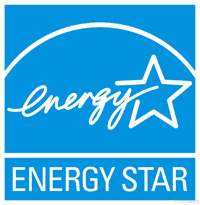
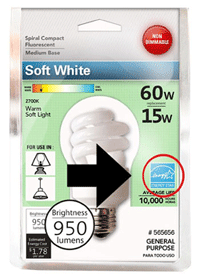
These are Energy Star rated products. Energy Star is an EPA sponsored organization set out to help businesses and individuals save money and the Earth's natural resources through superior energy efficiency. Each of these fixtures must pass a rigorous set of requirements to assure they are saving electricity every time you used them. The energy savings of these products range from 15 percent all the way to 80 percent depending on the product you choose. Energy Star has a large list of lighting fixtures and home appliances that will help you save on your heating and cooling usage.
How Does Saving Electricity Help the Environment?
We produce electricity in a large variety of ways. Every bit of energy we make has an impact on our environment, especially when finding unique ways to keep the huge turbines moving that make electricity. According to EPA, here are some of the effects that arise when creating energy. We are consuming our non-renewable resources at an alarming rate. We need to promote energy conservation or these resources will run out.
Natural Gas, Coal and Oil: Non-Renewable
How it’s made: Natural gas, coal and oil are fossil fuels that are formed when layers of buried organic matter are mixed with extreme pressure and heated over thousands or millions of years. These are all considered non-renewable resources that cannot be replenished in your lifetime.
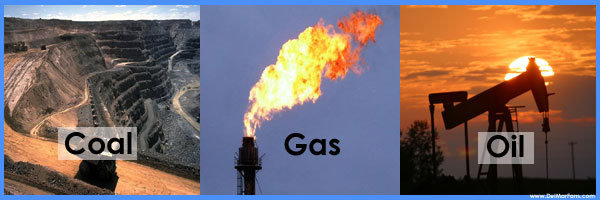
Effects on the Earth: Natural gas is extracted by drilling into the ground. These wells can potentially disturb animal and plant habitats. The water to cool the turbines is sometimes removed from rivers and lakes which can disturb the living environments for aquatic life and animals living near the water source. Both coal and oil are made in similar fashions in refineries.
Nuclear Energy
How it’s made: Nuclear power is how about 20 percent of America’s electricity is made. Nuclear energy is created by splitting uranium atoms in a technique called fission. Fission makes steam, which is used to generate electricity. The United State houses roughly 100 of these plants.
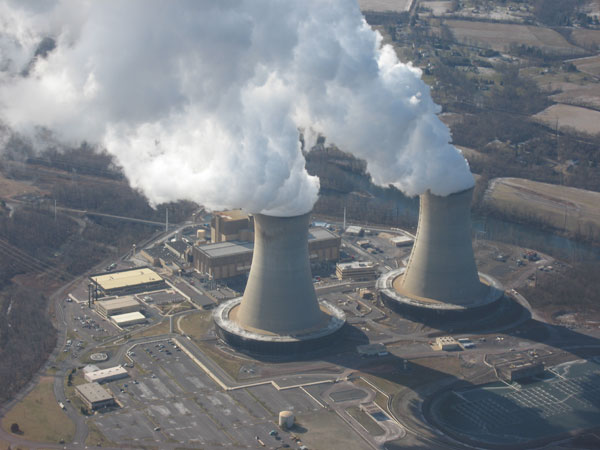
Effects on the Earth: If radioactive waste and spent fuel are not disposed of properly they can potentially be an environmental hazard. Ninety-nine accidents have been reported from nuclear power plants across the world, only a handful have been major.
Municipal Solid Waste
How it’s made: When you recycle, you help this program. Municipal solid waste is all of the garbage collected. Recycling is the favorable method of collecting this waste. The waste is taken to the energy plant and ripped into smaller, more manageable pieces before it’s burned to produce steam to turn the turbines. The price of building these plants is so expensive that new construction has been limited.
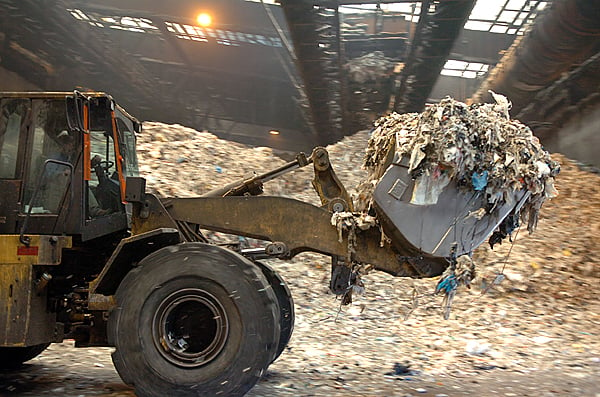
Effects on the Earth: These plants have potential to add to air pollution releasing toxins, nitrogen oxides and sulfur dioxide into the air. However, this procedure helps eliminate waste and landfills.
Hydroelectricity
How it’s made: Hydropower creates electricity by holding water at a man-made dam then forcing the water through a turbine to move it. Hydropower is considered a renewable energy source because although water evaporates it eventually rains back down.
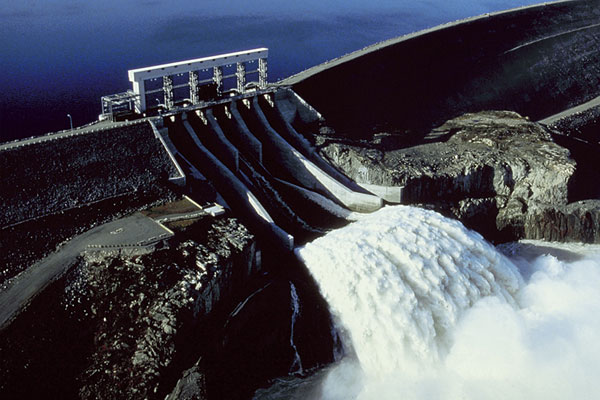
Effect on the Earth: While hydropower doesn’t affect air emissions or create any solid waste, the dams can affect the rivers bend and move and the wildlife in or around the water.
Non-Hydroelectric Renewable Energy
How it’s made: This includes the variety of other forms for creating energy using our renewable resources, including solar, geothermal, biomass, landfill gas and wind.
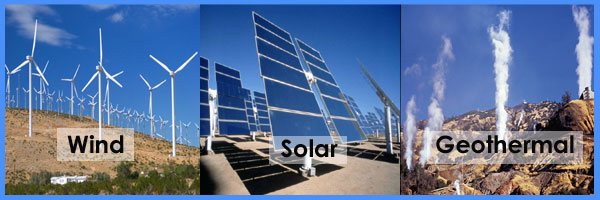
Effects on the Earth: These forms do not combust gases so air emissions are not compromised. Water is not used so water sources are not compromised. They do not create waste and rarely disturb the land around them.


